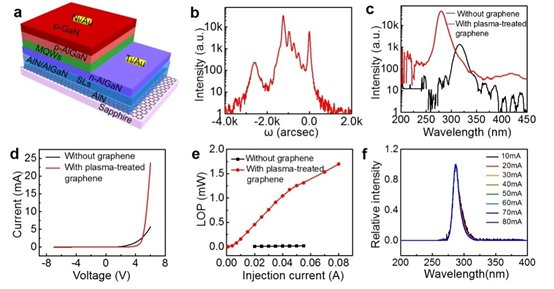Semiconductor Institute made new progress in the research of epitaxial deep ultraviolet LED on graphene
DUV LEDs can be widely used in anti-virus, sterilization, printing and communication fields. The proposal of the International Minamata Convention has promoted the full application of DUV LEDs. However, the commercialization of DUV LEDs has less than 10% external quantum efficiency. Limits the application of deep ultraviolet LEDs. The quality of AlN materials is one of the core factors of deep ultraviolet LEDs. AlN thin films are heteroepitaxially grown on c-sapphire, 6H-SiC and Si (111) substrates by metal organic chemical vapor deposition (MOCVD). AlN There is a large lattice mismatch and thermal mismatch between the substrate and the epitaxial layer, so that there is greater stress and higher dislocation density, which seriously reduces the performance of the device. At the same time, AlN precursors have higher migration barriers and poorer wettability on such substrates, tending to grow in a three-dimensional island shape, requiring a certain thickness to achieve fusion, increasing time costs.
Recently, the Lighting R & D Center of the Institute of Semiconductors of the Chinese Academy of Sciences has collaborated with the Liu Zhongfan team of the Nanochemistry Research Center of Peking University and the Beijing Graphene Research Institute to develop a new graphene / sapphire epitaxial substrate, and proposed plasma pretreatment modified graphene , Promote the growth of AlN thin film to realize the new strategy of deep ultraviolet LED. Through DFT calculations, it was found that the plasma pretreatment of pyrrole nitrogen introduced into graphene can effectively promote the nucleation growth of AlN thin films. A high-quality AlN thin film can be obtained in a short time, which has low stress and low dislocation density, and the deep ultraviolet LED device exhibits good device performance. The result was published in "Advanced Materials" (Adv. Mater., DOI: 10.1002 / adma.201807345) with the title of Improved Epitaxy of AlN Film for Deep-Ultraviolet Light-Emitting Diodes Enabled by Graphene. Semiconductor Institute researchers Li Jinmin, Wei Tongbo, Peking University Liu Zhongfan, and researcher Gao Peng are co-corresponding authors of the paper, and Chen Zhaolong and Liu Zhiqiang are co-first authors.
At the same time, Wei Tongbo and Liu Zhongfan teamed up to propose a growth model of epitaxial AlN for graphene / NPSS nano-patterned substrates. Theoretical calculations and experiments verified the enhanced law of metal atom migration on the graphene surface. Graphene shortens the merging time of AlN on NPSS by three points Second, at the same time, the power of the deep ultraviolet LED has been significantly improved, making the deep ultraviolet light source expected to become a breakthrough in the industrialization of graphene. Related achievements were selected as Featured articles after Appl. Phys. Lett. 114, 091107 (2019), and were specially reported by AIPScilight under the title of New AlN film growth conditions enhance emission of deep ultraviolet LEDs, and also by the semiconductor review magazine Compound The magazine edition (No. 3, 2019) and Semiconductor Today feature a long story at the same time.
In addition, in response to the international technical problems of p-type doping in deep ultraviolet light-emitting devices, Liu Zhiqiang proposed a new mechanism of defect resonance p-type doping. This method is based on energy band regulation and obtains an efficient acceptor ionization rate while maintaining a high The hole mobility of 0.16 Ω.cm achieves p-type gallium nitride conductivity, which lays the foundation for the subsequent application of graphene in transparent electrodes of deep ultraviolet devices. The related results were published in Semicond. Sci. Technol. 33, 114004 (2018), and won the 2018 Best Scientist Award for Young Scientists in the journal. The results were also positively evaluated by the 2014 Nobel Prize in Physics, Amano.
The above series of research work are supported by the National Key Research and Development Program, the National Natural Science Foundation of China and the Beijing Natural Science Foundation.

Schematic diagram of AlN nucleation on graphene and results of deep ultraviolet LED devices
We have 2 types of Large Diameter Hose: Frac Hose and Layflat Hose.
Frac hoses were produced through-the-weave, easy cleaning and no drying required.
Designed for long service life. Tough and durable with exceptional resistance to abrasion
And cutting for use on wide variety of environment conditions.
Protected against mechanical damages.
Very low elongation (compared with vulcanized process) under pressure, prevents hose from [snaking".
High resistance to heat, fuels, chemicals, UV, ozone, weathering,hydrolysis,and microbiological attack.
Tube & cover: thermoplastic, polyurethane (TPU)
Reinforcement: High tenacity polyester filament, circular weaving.
The special extrusion through-the-weave process gives a very strong bonding between cover and lining as well as firmly encapsulation the woven polyester.
Temperature range from -50℃ to +70℃.
We can supply frac hoses with size: 8``,10``,12`` and 16``.
Large Diameter Hose
Large Diameter Hose,25Mm Reel Hose,32Mm Reel Hose,Large Diameter Rubber Hose
NANTONG SENTIAN FIRE-FIGHTING EQUIPMENT CO.,LTD. , https://www.firehosefactory.com